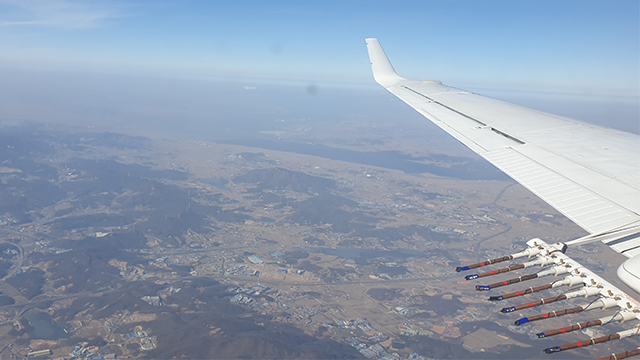The South Korean government’s first artificial rain experiment this year over the West Sea failed to remove toxic dust particles in the air because it barely induced precipitation, environment authorities said Wednesday.

Announcing the results of the experiment in detail, the Ministry of Environment and the Korea Meteorological Administration said a process called cloud seeding -- in which chemicals such as silver iodide are injected into clouds to increase the chances for rain or snowfall -- had increased the number of precipitation particles in the clouds to about 3.4 times the original number.
The government conducted the experiment in January in hopes that the artificial rain would prove helpful in reducing air pollution levels.
But only a small amount of precipitation was detected in two locations near islands. Inland areas did not see any rain due to the drier air near the ground and the scientists could not confirm that the artificial rain had reduced particulate pollution, they said.
Levels of ultrafine particles -- particles smaller than 2.5 micrometers in diameter -- temporarily decreased in the hours following the experiment, but this was mainly due to winds, according to the analysis.
“We will take into account changes of humidity near the ground for the next experiment,” said Joo Sang-won, a director-general at the National Institute of Meteorological Sciences.
Another 14 artificial rain experiments are planned for this year.
Earlier experiments carried out in the country saw increases in precipitation ranging from 0.1 to 1 milliliter per hour on average, due to technical difficulties. For artificial rain to be helpful in removing dust in the air, it would have been necessary to generate at least 10 milliliters of precipitation per hour for two consecutive hours, experts say.
As part of efforts to tackle particulate dust pollution, Korean Environment Minister Cho Myung-rae met with his Chinese counterpart in Beijing on Tuesday. They agreed to exchange artificial rain technology as a way of reducing fine dust, and to share their air quality forecasts more closely.
Amid growing disputes over which country bears the greatest responsibility for the toxic levels of particulate pollution on the Korean Peninsula, the ministers agreed to publish a long-delayed report on how airborne pollutants travel within Northeast Asia in November ahead of a trilateral ministerial meeting involving Korea, China and Japan.
(laeticia.ock@heraldcorp.com)
-
Articles by Ock Hyun-ju








![[Graphic News] More Koreans say they plan long-distance trips this year](http://res.heraldm.com/phpwas/restmb_idxmake.php?idx=644&simg=/content/image/2024/04/17/20240417050828_0.gif&u=)
![[KH Explains] Hyundai's full hybrid edge to pay off amid slow transition to pure EVs](http://res.heraldm.com/phpwas/restmb_idxmake.php?idx=644&simg=/content/image/2024/04/18/20240418050645_0.jpg&u=20240419100350)






![[From the Scene] Monks, Buddhists hail return of remains of Buddhas](http://res.heraldm.com/phpwas/restmb_idxmake.php?idx=652&simg=/content/image/2024/04/19/20240419050617_0.jpg&u=20240419175937)

![[KH Explains] Hyundai's full hybrid edge to pay off amid slow transition to pure EVs](http://res.heraldm.com/phpwas/restmb_idxmake.php?idx=652&simg=/content/image/2024/04/18/20240418050645_0.jpg&u=20240419100350)

![[Today’s K-pop] Illit drops debut single remix](http://res.heraldm.com/phpwas/restmb_idxmake.php?idx=642&simg=/content/image/2024/04/19/20240419050612_0.jpg&u=)